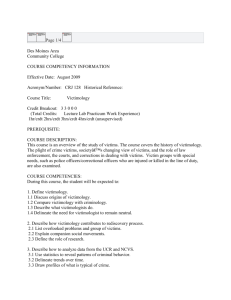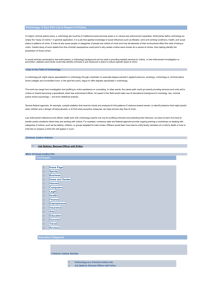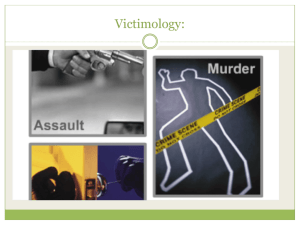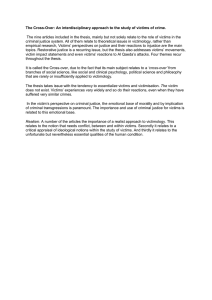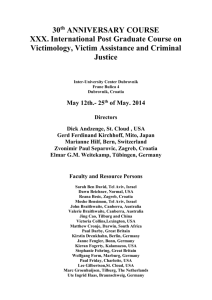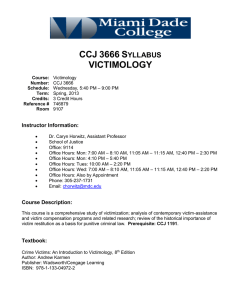Crime Victims: An Introduction to Victimology Chapter One: What is Victimology?
advertisement
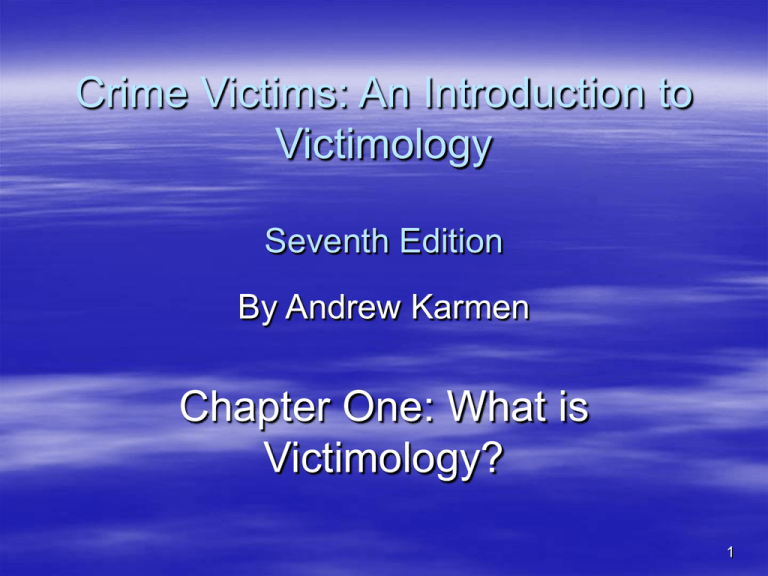
Crime Victims: An Introduction to Victimology Seventh Edition By Andrew Karmen Chapter One: What is Victimology? 1 VICTIMOLOGY “Scientific study of physical, emotional, and financial harm people suffer because of illegal activities.” Included in this definition is the victimization occurring for victims within the criminal justice system. 2 VICTIMOLOGY Victims—Individuals who experience loss, injury, or hardship for any reason Crime Victims—Above as result of an illegal act Direct/Primary Victims—Experience criminal act and its consequences first-hand Indirect/Secondary Victims—Family and those who suffer emotionally or financially but are not immediately involved. Can also include care-givers and first responders 3 Studying Victimization Scientifically Subjective Approach – Issues are approached from standpoint of morality, ethics, philosophy, personalized reactions, and emotions Objective Approach – Requires observer to be fair, open-minded, even-handed, dispassionate, neutral, and unbiased 4 Studying of Victimization Scientifically Why should victimologists NOT be provictim? “Ideal Victim”: person who suffered harm was weaker than aggressor, acting virtuously or not looking for trouble or breaking any laws, and wrongdoer was a stranger acting illegally and was unprovoked 5 Victims or Offenders? Who is the victim and who is the offender? Not always clear cut—consider the following: – Subway Vigilante – Menendez Brothers 6 Criminals as Victims Victims not always “innocent;” Examples – Gang members attacking another gang – Drug dealer ripping off a customer – A “john” robbing a prostitute (or vice-versa) 7 Cycle of Violence Cycle of violence over time can transform victim(s) into victimizer(s) – Group of picked on students may gang up against the bully – Battered wife may launch a vengeful attack against husband – Convicts much more likely to have been abused physically or sexually as children 8 Victims vs. “Good Guys” Victimologists do not limit their studies to clashes between victims and offenders They also consider the social reaction to victimization Victims are often “used” by other parties – Media sensationalizes some cases – Organizations with an agenda might use a victim’s plight for publicity, fund raising, etc. 9 Victimology’s Undeserved “Bad Reputation” Victimology during the 90s and into the twentieth century has become a “dirty word” to many people Do not confuse “victimism” with “victimology” “Victimology” is often misused, when the author intends to describe “victimism.” The next slide is an example of mis-using the word “victimology” 10 Victimology’s Undeserved “Bad Reputation” (Leo, 1994) a news magazine commentator complained, “We are deep into the era of the abuse excuse. The doctrine of victimology—claiming victim status means you are not responsible for your actions—is beginning to warp the legal system.” 11 Victimology’s Undeserved “Bad Reputation” Victimology is a new academic discipline that only means “the study of victims.” It is focused on the research about people harmed by criminals It does not impose a partisan point of view or a set or predictably biased conclusions The ideology of “victimism” is a coherent, integrated set of beliefs that shapes interpretations and leads to political action 12 Victimology’s Undeserved “Bad Reputation” Victimological research must tell the whole truth regardless of who is disappointed or insulted Three types of biases undermine the ability of any social scientist to achieve objectivity. They include: 13 Three Types of Bias 1. May arise from personal experience, taking the form of individual preferences and prejudices 2. Derives from the history of the discipline itself – Pioneers in the study of victimology first introduced the concept of victim-blaming – Today, majority of victimologists are pro-victim 14 Three Types of Bias 3. A subtle bias traced back to the mood of the times 60s-70s: a demand for government to devise ways to help victims get back on their feet financially, medically, and emotionally 80s: a theme of self-reliance and a reduction in government social spending and tax cutting gained popularity 15 The Origins of Victimology Box 1.3, Page 17, provides highlights in the brief history of Victimology and Victim Assistance Significant gains in the United States when the President’s Commission on Law Enforcement and the Administration of Justice urged criminologists to pay more attention to victims 16 Milestones in Victimology By the 1970s victimology became a recognized field of study By 1990, 240 colleges and universities offered courses in victimology Most states passed crime victim rights amendments to their state constitution 2004—Congress enacts the Crime Victims’ Rights Act which provides for fair treatment and opportunities for input in federal court proceedings 17 Victimology vs. Criminology Victimology is best viewed as an area of specialization within criminology Criminology embraces the scientific study of crimes, criminals, criminal laws and the justice system, societal reactions, and crime victims 18 Victimology vs. Criminology Victimologists ask why some individuals, households, and entities are targeted while others are not Criminologists ask why certain individuals become involved in lawbreaking while others do not 19 Victimology vs. Criminology Criminologists apply their findings to devise crime prevention strategies Victimologists use patterns and trends to develop victimization prevention strategies and risk-reduction tactics Both criminologists and victimologists study how the criminal justice system actually works versus how it is supposed to work 20 Victimology vs.. Criminology Boundaries – Boundaries are clear cut for Criminology – Boundaries for Victimology still unclear – Overlap due to lack of boundaries Crime rates vs. victimization rates 21 Divisions Within The Discipline Conservative Influence – Focuses primarily on street crimes – Everyone to be held accountable for their decisions and actions – Emphasis on self reliance, NOT government – Individual responsibility for preventing, avoiding, resisting and recovering from criminal acts – Strictly punish offenders on behalf of their victims 22 Divisions Within The Discipline Liberal Influence – Scope of field to extend beyond street crimes – Endorse government intervention – Extend ‘safety net’ mechanisms for all kinds of misfortunes – Look to wrongdoers repaying their victims to allow for reconciliation 23 Divisions Within The Discipline Radical/Critical/Conflict Influence – Victimization is a result of oppressive social system – Looks toward societal factors such as poverty, unemployment, language barriers, etc as explanations behind crime 24 What Victimologists Do Victimologists explore the interactions between victims and offenders, victims and the criminal justice system, and victims and society Victimologists study the ways in which crime victims are harmed, including physical injury, psychological trauma, and financial loss. 25 What Victimologists Do Four step process victimologists follow when carrying out their research: Step 1: Identify, Define, and Describe the Problem Step 2: Measure the True Dimensions of the Problem Step 3: Observe How Victims Are Handled Step 4: Gather Evidence to Test Hypotheses 26 Chapter One Key Terms Victim Victimization Victimology Direct/Primary Victims Survivors Indirect/ Secondary Victims Subjective Approach Objectivity Sensationalism Victimism Ideology Criminology Post-Traumatic Stress Disorder Crime Control Just Deserts Operationalization Muggability Ratings Stockholm Syndrome Incidence Rates Prevalence Rates Lifetime Likelihoods Profile Needs Assessment Ideal Type Plea Negotiations 27
